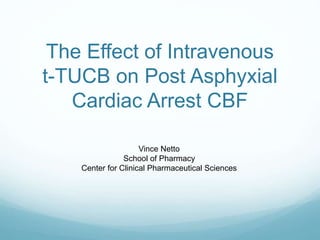
The Effect of Intravenous t-TUCB on Cerebral Blood Flow Following Asphyxial Cardiac Arrest
- 1. The Effect of Intravenous t-TUCB on Post Asphyxial Cardiac Arrest CBF Vince Netto School of Pharmacy Center for Clinical Pharmaceutical Sciences
- 2. Asphyxial Cardiac Arrest Cardiac arrest (CA) brought on by obstructed breathing (or asphyxiation) 70% of those that survive suffer permanent neurological damage No approved pharmacological treatment exists to prevent neurological damage
- 3. ACA and Cerebral Blood Flow SHAM CA-NS CA- Albumin CA- PNABase line 5 min 30 min 60 min 90 min 150 min Sham CA NS CA albumin CA PNA ProbeTrial Time(sec) 0 10 20 30 40 50 60 Morris Water Maze
- 4. sEH Inhibitors: t-TUCB Role of EETs in CBF COOH Arachidonic Acid PLA2 Epoxyeicosatrienoic Acids (EETs) (Vasodilatory and neuroprotective) Soluble Epoxide Hydrolase (sEH) Dihydroxyeicosatrienoic Acids (DiHETEs) (Inactive) CYP450
- 5. Hypothesis Intravenous administration of t-TUCB in PND 17 rats resuscitated from ACA will raise EET levels in the brain and consequently impart neurological protection by increasing cerebral blood flow.
- 6. Objectives Develop and validate an assay to test plasma and brain concentrations of t-TUCB Develop and test an IV formulation of t-TUCB Discover the optimal dose of t-TUCB via Pharmacokinetic Study Determine the effect of t-TUCB on cortical CBF following ACA
- 7. Methods T-TUCB and ARA metabolite quantification with Waters Acuity liquid chromatographer and TSQ triple quadrapole mass spectrometer Isoflurane Fentanyl 50 mcg/kg/h Vecuronium 5 mg/kg/h PREPARATION Intubation Catheters ANOXIA 12 min Sham BASELINE CBF RESUSCITATION Chest compressions Epinephrine Sodium bicarbonate Normal Saline POST RESUSCITATION Serial CBF Laser Speckle Contrast Analysis (Pericam PSI) 5, 10, 15, 30, 45 min 1, 1.5, 2, hr
- 8. Regional CBF After Asphyxial CA in Immature 17 Day Old Rats* *Manole et al, JCBFM 2009 5 min 120 min sham Cortical8,9-EET 0 10 20 30 40 50 60 70 5 min 120 min sham Cortical8,9-EET 0 10 20 30 40 50 60 70 9 min 12 min EET After ACA EET After ACA
- 9. Assay Validation Diluted 20 times in Serum/DI water matrix T-AUCB (sEH inhibitor) as internal standard Duplicate standard curve run each of 3 days 6 QCs on days 1 and 2 12 QCs on day 3
- 10. Pharmacokinetics 6 hours Post Dose Half Life Mean Brain [C] t-TUCB 30.42 nM 13 hours Times Above IC50 (16 nM) 1.9 • 1 mg/Kg • 10% Hydroxypropyl Beta Cyclodextrin • Lyophilization • 0.1667 mg/mL t-TUCB y = -14.594x + 335.41 R² = 0.6224 10 100 1000 0 2 4 6 8 t-TUCBconcentration(ng/mL) Hours After IV Injection Mean Plasma t-TUCB [C] (ng/mL) vs Time (hours)
- 11. Mean Blood:Brain t-TUCB at 2 Hours T-TUCB is about 15 to 20 times higher in Plasma Brain concentrations at 2 hours were well above IC 50 0 5 10 15 20 25 30 1 Blood:Brainratiot-TUCB Experimental Groups ACA Drug Sham Drug ACA Vehicle
- 12. Test of Treatment [C] We tested the IV formulations given to each group of rats for t-TUCB concentration Concentration was about 75 % of target 0 0.02 0.04 0.06 0.08 0.1 0.12 0.14 0.16 1 Concentrationt-TUCB (mg/mL) Experimental Groups ACA Drug Sham Drug ACA Vehicle
- 13. CBF Post Resuscitation No significant Difference between rats treated with t- TUCB and rats treated with Vehicle 0 0.2 0.4 0.6 0.8 1 1.2 1.4 CBF(%ofBaseline) Time Point Cortical CBF (% baseline) vs Time ACA Drug ACA Vehicle Sham Drug Vehicle T-TUCBSham 5 min 60 min 120 min
- 14. Conclusions A validated assay has been developed to measure t-TUCB in rat plasma An IV formulation of t-TUCB has been developed, though batch to batch variation in [C] exists T ½ is estimated to be 13 hours in PND 17 rats T-TUCB was present in the brain at ~ 2 times IC 50 at both 2 and 6 hours Post ACA CBF was no different between t-TUCB and vehicle groups
- 15. Future Directions Test whether EET levels are raised at a dose of 1 mg/Kg t-TUCB Demonstrate whether the increase in EET concentrations have activated known signal transduction pathways for neurological protection (PI3K/AKT or ERK 1/2) Test the effect of 1 mg/Kg t-TUCB on neurological outcomes (Morris Water Maze and histological assessment of neuron survival)
- 16. Acknowledgements Li Lingjue Dr. Poloyac and Dr. Manole S.K. Bhasha Safar Center For Resuscitation Research Funding: Pittsburgh Research and Investigational Summer Experience Program (AHA)
Editor's Notes
- 8